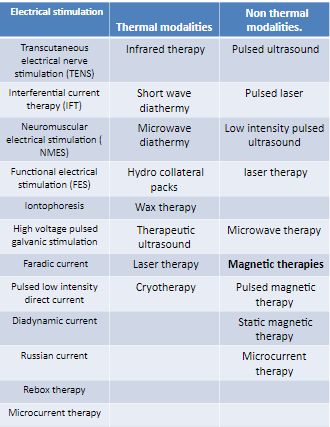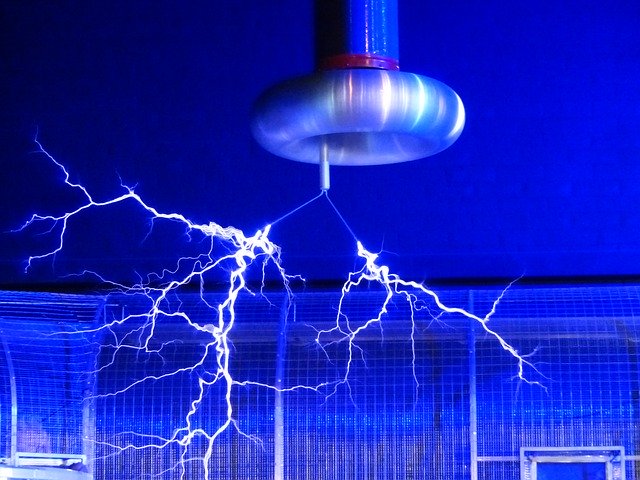Electrotherapy- Healing with Electricity
Electrotherapy :
With advancements in the field of Physiotherapy, people are inclined towards pain reducing treatment methods that are effective, non-invasive and without side effects. Now most of us do not prefer to use strong pain killers and steroidal drugs. Among all the options, Physiotherapy has multiple ways of treatment which includes various electrotherapy devices and modalities.
Most of the patients who have visited a Physiotherapy clinic must have used some or the other electrotherapy modality. While going through this treatment people have various doubts about the way electrotherapy works. Because it uses electricity for treatment some patients are afraid while using this.
So, let’s clear out all your doubts and fears about electrotherapy….
1) What is electrotherapy?
Electrotherapy is the use of electrical energy for medical treatment. First use of electrotherapy dates back to the 17th century or even before that. It is a non invasive way of treatment which is comparatively economical and with very few side effects. There are electrotherapy devices which are used for medical diagnosis or for treatment. E.g. EEG, ECG, Brain stimulator.
2) When to use electrotherapy?
Primary use of electrotherapy is for pain reduction. Pain might be due to some:
- Sport injury
- Chronic pain
- Acute pain
- Back pain
- Frozen shoulder
- OA knees
- Ankle sprain and many more.
For re-educating muscle after some neurological injuries:
- Stroke
- Spinal cord injury
- Tendon transfer
- Peripheral nerve injury
- Traumatic brain injury
Fracture healing
Wound healing
3) How long to use electrotherapy?
This is totally dependent on your pathology, intensity of pain, extent of injury, region of injury, type of modality you are using and other comorbidities. And at the end, clinical examination and decision given by your Physiotherapist plays a crucial role in this question.
4) What should be the dosage of treatment?
Again to some extent it depends on type of injury, region of injury, duration of injury, comorbidities and judgment of your therapist. The treatment is given within tolerable range of intensity. If a patient feels any kind of discomfort or pain, the treatment is modified accordingly. All the necessary precautionary measures are taken to avoid any hazards.
5) What all precautions should be taken?
- In the region of altered sensation, modify the electrodes placements.
- Patients with cardiac conditions, cardiac arrhythmia and epilepsy should be under continuous monitoring during electrotherapy treatment .
- In treatment methods like cryotherapy (use of ice) and hydrotherapy (use of hot water) make sure that the part is not water logged.
- Particularly while treating the trunk region do not lie down on electrodes or hot packs.
- Avoid direct use of electrotherapy modalities on epiphyseal regions of children.
- Avoid use of photosensitive drugs or body lotion during treatment methods.
- Do not wear metal ornaments during the treatment method.
6) What are the electrotherapeutic modalities used in Physiotherapy?
Since early days, delivery of electrotherapy has changed remarkably. The newer methods used in Physiotherapy treatment these days are quite dissimilar to those 60 years back. There are various modalities available which can be used according to the condition of the patient. Physiotherapist is always in the best authoritative position to decide.
Modalities can be classified as Thermal, Non thermal and Electrical stimulation-

- Interferential therapy: Two medium frequency current are made to interfere so as to form a low frequency current.
- Transcutaneous Electrical Stimulation: Pulsed biphasic electrical current. Digital TENS machines are widely becoming available with features like automated frequency sweep, complex stimulation pattern. Some devices have pre-programmed settings.
- Neuro-Muscular Electrical Stimulation (NMES): Retrain/ re-educate the muscle. It can be EEG triggered or EMG triggered.
- Functional Electrical Stimulation (FES) : Used after stroke or muscle paralysis
- Faradic Stimulation: Low frequency alternating milliamperage current delivered in series of short pulses a few milliseconds in length.
- High voltage pulsed galvanic current : Used monophasic pulsed current
- Diadynamic current: Use various forms of waves to get an effect which is more comfortable than other methods.
- Rebox Therapy: (Rehabilitation Box): Specific impulses (frequency 2–4 kHz, pulse width 100-300 μs) of weak electric currents (100-200 μA) are introduced with a touch of a small non-invasive treatment electrode (cathode) while the patient holds a second reference electrode (anode) in a hand to complete electric circuit.
- Ultrasound: Utilize sound energy. Pressure waves are formed by mechanical vibration of particles in a medium.
- Diathermy: Diathermy is electrically induced heat or the use of high-frequency electric currents as a form of physical therapy.
- Pulsed Electromagnetic Field: The original PEMF devices consisted of a Helmholtz coil which generated a magnetic field. The patient’s body was placed inside the magnetic field to deliver treatment. Today, the majority of PEMF devices resemble a typical yoga mat in dimensions but are slightly thicker to house several flat spiral coils to produce an even electromagnetic field.
- Quantum Resonance Therapy: It is an advanced treatment method that uses a combination of PEMF and MMO (Magneto mechanical oscillator).It is developed by Quantesla. Device is named Celtron. MMO is a hand held device that produces healthy intrinsic frequencies. It helps to increase lymphatic flow, increase circulation, increase cellular permeability and reduce pain.
7) Who can provide the electrotherapy treatment?
Physiotherapists are experts and authorized practitioners in this field of treatment. They can give appropriate dosage for appropriate conditions. Also they are trained in managing or modifying the treatment to further improve recovery speed. Nowadays there are some Pocket TENS machines or other pain relieving machines available to use at home. Before using such a device, it is always advisable to know the scientific information and directions of usage from your therapist.
8) How to combine electrotherapy with other treatment techniques?
To have long lasting and maximum effect, electrotherapy should be combined with rest, exercise therapy, manual therapy, postural modification , ergonomic changes and sometimes drug therapy. Solo use of electrotherapy might reduce your pain, but the effect is not sustainable. To have long lasting results and to avoid recurrence of pain you have to follow the combined protocol.
In a nutshell, smart use of electrotherapy is always effective with innovative modalities.
“‘Electricity is the soul of the universe.” – John Wesley
Read More:
High Technology for Physiotherapists!
A fine touch of electromagnetic healing!
A Story of Bio-electromagnetic Healing!
